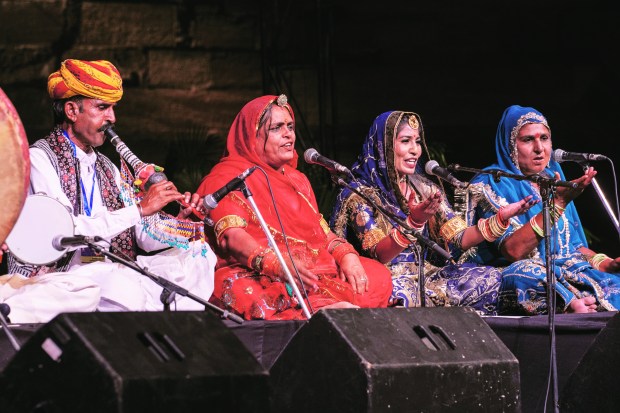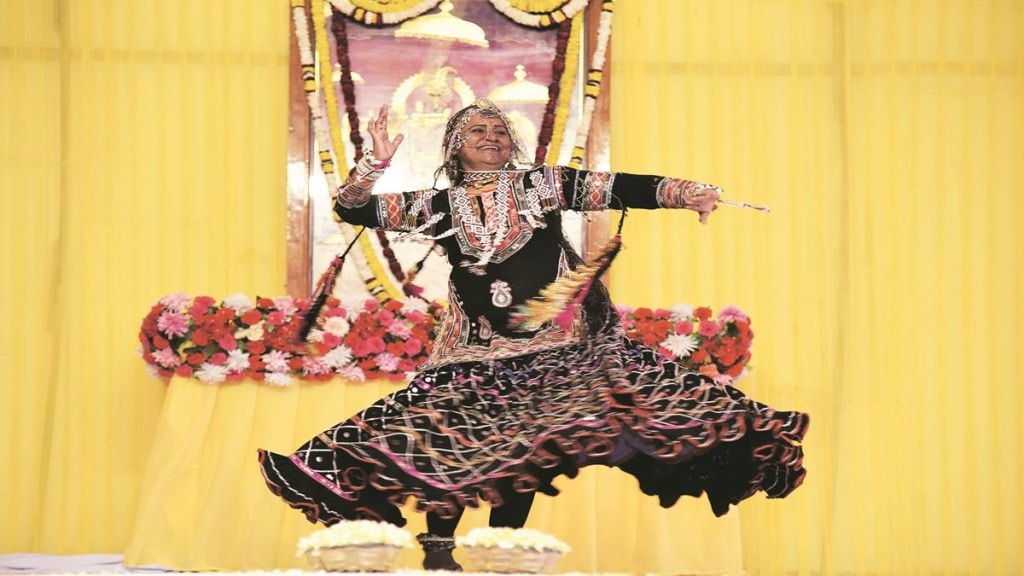On a clear October night, as the moon shines in its full glory coinciding with Sharad Purnima (a religious festival celebrated on the full moon day of the Hindu lunar month of Ashvin), Asha Sapera (27), Mohini Devi (40) and Sugana Devi (40) walk up to the open-air courtyard at Jodhpur’s Mehrangarh Fort, the venue of the 2023 edition of Rajasthan International Folk Festival (RIFF). As the women belonging to the Kalbelia community start singing songs of love, longing and local folklore, with the accompanying men playing the traditional pungi, dafli and manjira beside them, the 15th-century palace-turned-museum suddenly comes alive, reverberating with the powerful voices and the audience’s applause, both in tandem with one another.
Soon, the tempo of the music rises, and so does the energy, and Asha Sapera then gets up to show her serpent moves, providing a glimpse into their signature Kalbelia dance—the face of this once-nomadic community from Rajasthan’s Thar desert.
“Originally, we were snake charmers. It was our primary occupation— taking out their poison, making medicines with it, and even soorma (eyeliner), and make them dance to the tune of the pungi,” says Mohini Devi. Delving a sharp blow to their livelihood, the government outlawed the practice under the Wildlife Protection Act of 1972. “So the snakes were gone, and we, the Kalbelia women, began dancing to the tunes of the pungi, dressed in black,” adds Asha Sapera.
Over the years, the women have replaced the snakes, both as the face of this tribal community as well as a crucial pillar of livelihood. With women twirling at a rapid pace, dressed from top to bottom in a voluminous black attire, and concocting their bodies in ways unimaginably akin to the movement of snakes, Kalbelia dance is now known worldwide. It is even inscribed in Unesco’s list of ‘Intangible Cultural Heritage’ that includes traditions or living expressions inherited from our ancestors and passed on to our descendants.

It is no small feat, given Rajasthan’s abysmal gender metrics, with sex ratio being 928 females for every 1,000 males, much below the national average of 940:1,000. Similarly, the female literacy stands at 52.12%, much lower than 79.19% among males. Birth rate, which is the number of live births per 1,000 persons, is 24, more than India’s 20; and the maternal mortality rate is an abysmal 388 per 1,00,000 live births compared to India’s 254. Female foeticide, infanticide and child marriage remain pressing issues.
In the face of these alarming figures, the Kalbelias appear to be an outlier. Women are in the spotlight, dancing and singing their way to the world stage, but at the same time they are struggling to earn a decent livelihood with a ban on their traditional profession of snake handling.
A girl named Gulabo
In the world of dance, Gulabo Sapera is a force to reckon with. Responsible for popularising the dance form across India and abroad single-handedly, she received India’s fourth-highest civilian award Padma Shri in 2016, the first person from her community to receive the honour.
While she is now a prominent face of Rajasthan’s vibrant culture, Gulabo suffered a fate similar to most women born in the region. Just an hour after birth, in Pushkar in 1973, she was buried alive. It was her mother and aunt who dug her out, and the rest is history. Gulabo spoke about her birth and survival as she participated in the reality television show Bigg Boss in 2011.
In an earlier interview with The Indian Express, she shared how the Sapera community, traditionally involved in snake catching and charming, didn’t want to be burdened with looking after their daughters in the jungle encampments, and hence, killed them.
While Gulabo evaded the same fate, her journey wasn’t easy. In 1981, after being spotted by a government official as she was performing at a fair, the family was shunned by the villagers as they came to know about the performance. However, a few days later, she was called to perform at Jaipur’s Ram Bagh. Swiftly, she made it to the international stage as she performed in Washington in 1985.
Speaking with Tripti Pandey, the government official who had first spotted her, at the Jaipur Literature Festival in 2021, Gulabo reminisced about the villagers’ reaction once she returned from the United States. The people who had shunned her and her family once, now wanted Gulabo to teach their daughters. To this, she replied, “Aap betiyan bachate kahan ho? Betiyon ko toh sab maar dete ho (Do you let your daughters live? You murder them all).”
Interestingly, the black garment, which is very much the identity of Kalbelia dance, too, is attributed to her. “According to Komal Kothari (the late founder-director of Rupayan Sansthan, Jodhpur) Kalbelia women originally wore salwar-kameez and odhni as their daily wear. They danced in the streets and markets in their best daily wear,” writes Dr Kiran Kapoor in her 2022 book Expressions of the Soul: Folk Dances of Rajasthan, Costumes, Culture and Traditions. “Gulabo introduced the black Kalbelia dance costume, black being the essence of the serpentine dance. Gradually, the Kalbelia dancers adopted the black ensemble for performing, as it not only lends beauty to the dance but also depicts the theme of the Kalbelias’ snake dance,” she adds. Over time, “This highly decorative three-piece ensemble worn by Gulabo—black jumper, ghaghra and odhni—has become the Kalbelia dance costume.”
One can only imagine the fate of Kalbelia dance, culture and tribe if a mother hadn’t saved her daughter from being killed.
Twirling her way to the global stage
Meanwhile, at RIFF, a day after her performance, Asha Sapera conducts a dance workshop, familiarising the attendees with her snake moves. She is assisted by her nieces Pooja and Rani, while her nine-year-old daughter Nandini takes hold of the camera capturing her mother’s moves, while joining her now and then, and even correcting the attendees when they put a foot wrong.
The attendees comprise mostly women, but also men, from India and abroad across ages, and even trained dancers.
“I have several students in India and abroad,” she says, taking pride in her craft and the journey she has had. Alike Gulabo, she started dancing young, at 10, and was spotted for her craft, and more offers to perform followed. While now she has had a long career, she specifically remembers her first trip abroad—to Hong Kong. “I was so excited, and was just thinking how the plane would take off, and land,” she shares. A performance that is memorable is the one in Panama, where at an event, representatives from other countries came with a huge group, but she travelled as a group of three. “We did not have the budget for the whole crew. But once we started performing, the numbers didn’t matter. Post our performance, the organiser came to us and said, ‘You people created a blast,’” she reminisces.
It is a formidable feat achieved by a girl, who was married off at just six months. “I was a baby and only got to know later on that I was already married,” she says. With stiff opposition from Asha, the marriage was ultimately annulled. While she put her foot down when it came to marriage, she still holds regret of not going to school, of not being formally educated.
“In our community, an early marriage is an issue. At the same time, there is lack of education. However, now, we are aware of these, and send our kids to schools,” she says.
Having married a second time, the going wasn’t any easier either. “My in-laws weren’t supportive of my career. They didn’t like that I danced. They wanted me to stay at home,” she says. Having divorced, she is now a single mother raising her nine-year-old while performing and teaching the world over.
For her daughter, she wants her to “study well, but at the same time, learn our craft. Singing and dancing is our tradition and it shouldn’t die”.
Just like Asha, who learned dancing seeing her mother and grandmother perform, the same seems to be happening with her daughter. In fact, it is an intrinsic aspect of the Kalbelia tradition, where the craft is passed on from one generation to the next. While the women sing and dance, men play the instruments.
Although often accompanied by family, performing can at times be especially challenging. Speaking on the uncomfortable male gaze, Rani and Pooja say, “At times, that happen. They think our performance is just like some Bollywood dance number.” However, they have their own way of dealing with this. “At times, we ignore. However, if it goes beyond a certain point, we just sit our ground and don’t perform,” they say.
All this makes the Kalbelias a community of deep contrast, where women are shunned at the back while being the face of the tribe.
However, the women are striving on.
“I wish we do something else too apart from dance,” says Asha, highlighting that there is no regular money. “If we get shows, then we get paid,” she says.
Meanwhile, the Kalbelia women are engaged in another craft—quilt making, which brings them money during the lean season. However, education and diversifying occupation is crucial here, highlights Asha.








